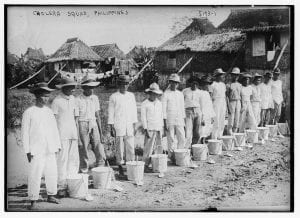In this article, Juliet Romano analyzes the similarities between American and German propaganda aimed towards women during World War II. The propaganda posters illustrate how cultural differences between the roles of German and American women were wiped away during the war.
Author: Stony Brook Undergraduate History Journal
A War on Two Fronts
In this paper, Jan Jandayran discusses how the 1902 Cholera Epidemic was not a result of the Philippine-American War, but rather as an epidemic that occurred in conjunction with the war. The relationship between cholera, American anti-guerilla policies, and the Filipino reaction to American epidemic policies are examined in this article.
The Lessons of Kingship: The Tale of Beowulf to King Alfred of Wessex
This paper analyzes whether the qualities of a good king are parallel between King Alfred and the epic poem Beowulf. The Anglo-Saxon ideals of kingship are explored through the dialogue between the historical sources about King Alfred’s life and the Old English epic Beowulf.
McGann v. H & H Music Company and HIV/AIDS Workplace Visibility in the Legal Setting
This paper is a legal brief on the cases of John McGann against H & H Music Co. that examines how McGann’s fight to have his medical expenses covered after his HIV diagnosis reflected the struggles of those around the country who experienced similar discrimination during the beginning of the AIDS epidemic.
Chocolate Pudding and Space Aliens: How the Heaven’s Gate Cult Propagated
Heaven’s Gate was a cult founded in the 1970s. In this paper Michael Corcoran analyzes the rhetoric the leaders used by examining three tapes that were produced in the final two years of the cult. These tapes reveal how Heaven’s Gate used social isolation to reinforce their indoctrination, which effectively reinforced the beliefs of the cult. These processes led to the death of the members of Heaven’s Gate, the largest mass suicide on U.S. soil in history.
“We don’t want your rations. We want this dance:” Native American Dance and The Battleground for Native Identity
Dance is a central aspect of Native American culture. Thus, it is no surprise the U.S. government explicitly attempted to erase these practices. However, Native resistance preserved these dances, and today they serve as both a means of preserving tradition while expressing and celebrating Native identity.
Thracians Through the Eyes of the Greeks
Classicists have long overlooked Thracian art due primarily to a Greek-centric view of the ancient world. Despite this, Ancient Thrace, similar to Greece, had an exceptional material culture that displayed sophisticated craftsmanship that rivaled the quality of Greek art.
El Deber Revolucionario: “The duty of the revolutionary” As a Defining Element of 1960s Latin American Youth
The idea of El deber revolucionario, or “the duty of the revolutionary,” echoed throughout Latin American youth culture during the 1960s from literature to art and music as young men and women expressed their countercultural political beliefs.
The Puerto Rican Experience in the South Bronx: An Oral History With Lizette Piedra
My mother, Lizette Piedra, grew up on Valentine Avenue in the South Bronx projects. In an oral history interview, she has narrated her experiences of the living conditions and crimes committed in her neighborhood during the 1970s and 1980s.
Herodotus, Homer, and The Histories
This paper, by Patrick Larkin, discusses the Homeric influence on Herodotus’ account of the Battle of Thermopylae









